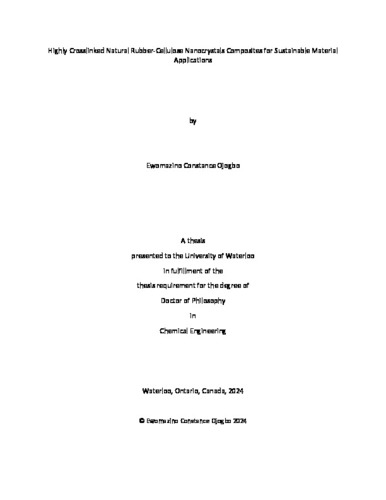| dc.description.abstract | In a bid to develop environmentally friendly rubber materials, the use of renewable and sustainable additives and reinforcing fillers that could provide suitable mechanical property enhancement is of great interest. In this thesis, cellulose nanocrystals (CNCs) are employed as reinforcing fillers due to their availability, sustainability, high aspect ratio, and excellent mechanical properties. In the first part of this study, various processing and fabrication methods of natural rubber (NR) – CNCs nanocomposite formulations were investigated to obtain optimal dispersion of CNCs and hence physical properties. Rheology, morphology, and various physico-mechanical property testing were also employed to understand the effects of the processing method on the NR-CNC vulcanizates. While co-coagulation and extrusion provided improved reinforcement of the nanocomposites attributed to the optimal dispersion of CNCs, batch mixing processed samples exhibited poor dispersion even at low CNCs loadings as observed from transmission electron microscopy and inferior composite properties.
The second and third part of this thesis involved chemical modification of the CNCs to enhance hydrophobicity and increase dispersion. Firstly, CNC was grafted on epoxidized natural rubber (ENR) in a base thermo-catalyzed reactive extrusion process. Successful grafting was confirmed using Fourier transform infrared spectroscopy (FTIR), X-ray photoelectron spectroscopy (XPS), and toluene swelling experiments. The new covalently grafted ENR – CNC was then added as a masterbatch into a rubber formulation. The ENR acted as a carrier of CNCs in the rubber leading to efficient dispersion of the CNCs and subsequently improved the tensile strength and rheological properties of the composite. In a separate study, CNC was modified with 3-isocyanotopropyltriethoxysilane (IPTS) and employed as a reinforcing filler for natural rubber. Successful modification was verified using FTIR and nuclear magnetic resonance (NMR) spectroscopy. As it is important to retain the crystalline structure of the CNC after modification, X-ray diffraction (XRD) studies showed that the crystal structure of the CNC was retained. The composition of the modified CNC with natural rubber improved the mechanical properties, reduced the cure time, and had no negative effect on the processability.
Overall, this study aimed to develop environmentally friendly and renewable nanocomposite systems based on rubber and CNCs in a bid to replace or complement the incumbent fillers in the rubber industry. Particularly, to generate knowledge on the chemical modification, processing, and applications of CNC in highly crosslinked rubber compounds, and investigate their suitability in material applications such as tires. | en |

